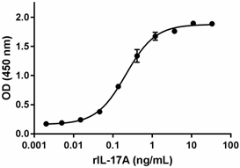- Regulatory Status
- RUO
- Other Names
- Interleukin 17, Il17, IL-17, CTLA-8, IL-17A

-

Rat IL-17A induces IL-6 in fetal mouse skin fibroblasts production in a dose dependent manner. The ED50 for this effect is 0.1 – 0.6 ng/mL.
| Cat # | Size | Price | Quantity Check Availability | ||
|---|---|---|---|---|---|
| 778701 | 5 µg | $59.00 | |||
| 778704 | 25 µg | $159.00 | |||
Select size of product is eligible for a 40% discount! Promotion valid until December 31, 2024. Exclusions apply. To view full promotion terms and conditions or to contact your local BioLegend representative to receive a quote, visit our webpage.
IL-17A was initially identified from a subtracted cDNA library between closely related murine lymphoid cells and it was named CTLA-8. IL-17A shares 58% homology with an open reading frame of the T-lymphotropic Herpes virus Samirii virus (viral IL-17). IL-17A belongs to a family of cytokines, which has six members; designated IL-17A-F. IL-17A is expressed by a unique lineage of CD4 T cells, Th17 cells. This lineage selectively produces proinflammatory cytokines including IL-17A, IL-17F, IL-21, and IL-22. In the mouse, the differentiation of this new lineage is initiated by TGFβ-1 and IL-6 or IL-21, which activates STAT3 and induces the expression of the transcription factor retinoic acid-related orphan receptors (RORγt and RORα). IL-23, which also activates STAT3, serves to maintain Th17 cells lineage.
Product Details
- Source
- Rat IL-17A, amino acid Ala26 – Ser158 (Accession # NP_001100367) was expressed in E.coli. The amino terminal contains Met.
- Molecular Mass
- The 134 amino acid recombinant protein has a predicted molecular mass of approximately 15 kD. The predicted N-terminal amino acid is Met.
- Purity
- >95%, as determined by Coomassie stained SDS-PAGE.
- Formulation
- Lyophilized from a sterile (0.2 micron) filtered aqueous solution containing 10 mM sodium citrate, pH 3.0
- Endotoxin Level
- Less than 1.0 EU per μg protein as determined by the LAL method.
- Concentration
- 10 and 25 µg / vial
- Storage & Handling
- Unopened vial can be stored at -20°C or -70°C for up to one year. After reconstitution, for three months at -20°C to -80°C and for one month at 4°C. For maximum results, quick spin vial prior to opening. Reconstitute in water to a concentration of 0.1-1.0 mg/mL. Do not vortex. It is recommended to further dilute in sterile buffer, such as 5% Trehalose, and store working aliquots at -20°C to -80°C. Avoid repeated freeze/thaw cycles.
- Activity
- Rat IL-17A induces IL-6 in fetal mouse skin fibroblasts production in a dose-dependent manner. The ED50 is 0.1 – 0.6 ng/mL.
- Application
-
Bioassay
- Product Citations
-
Antigen Details
- Structure
- Dimer
- Distribution
-
Activated memory T lymphocytes, CD4+ T helper cells (Th17), neutrophils, CD8(+), NK, and gamma-delta T cells
- Function
- IL-17A is a potent regulator of granulopoiesis and neutrophil recruitment under normal and inflammatory conditions. Organ overexpression of IL-17A increases circulating neutrophil numbers and recruitment into the organs by induction of CXCL2, IL-1β, and G-CSF. IL-17A induces CXCL1, CXCL2, CXCL5, and CXCL8 in human epithelial cells. IL-17A also cooperates with TLR ligands, IL-1 beta, and TNF alpha to enhance inflammatory reactions and stimulate production of beta-defensins and other antimicrobial peptides. Th17 differentiation of naïve T cells is markedly suppressed in the presence of IFNα.
- Interaction
- Epithelial cells, fibroblasts, B and T lymphocytes, myelomonocytic cells, and marrow stromal cells.
- Ligand/Receptor
- Heteromeric receptor composed of IL-17RA and IL-17RC.
- Biology Area
- Cell Biology
- Molecular Family
- Cytokines/Chemokines
- Antigen References
-
- Yu J, et al. Front Biosci 13:170-177 2008.
- Toy D, et al. J. Immunol. 177:36-39 2006.
- Benghiat FS, et al. Transplant Rev 23:11-18 2009.
- Honorati MC, et al. Rheumatology 40:522-527 2001.
- Rouvier E, et al. J. Immunol. 150:5445-5456 1993.
- Liang SC, et al. J. Immunol. 179:7791-7799 2007.
- Ouyang W, et al. Immunity 28:454-467 2008.
- Gene ID
- 301289 View all products for this Gene ID
- UniProt
- View information about IL-17A on UniProt.org
